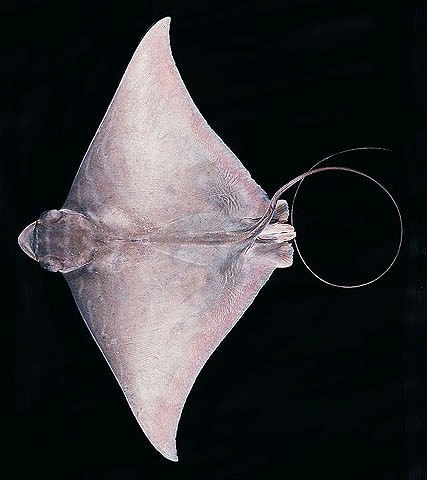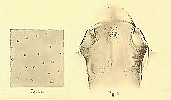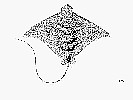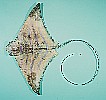Aetomylaeus nichofii
(Bloch & Schneider, 1801)
Banded eagle ray
Classification: Elasmobranchii Myliobatiformes Myliobatidae
Reference of the original description
M.E. Blochii Systema Ichthyologiae iconibus ex illustratum. Post obitum auctoris opus inchoatum absolvit, correxit, interpolavit. J.G. Schneider, Saxo: 584 p., 110 pl.
M.E. Blochii Systema Ichthyologiae iconibus ex illustratum. Post obitum auctoris opus inchoatum absolvit, correxit, interpolavit. J.G. Schneider, Saxo: 584 p., 110 pl.
Image of the original description
No image in first description.
No image in first description.
Synonyms / new combinations and misspellings
Aetomylaeus cf. nichofii, Aetomylaeus huletti, Aetomylaeus nichoffi, Aetomylaeus nichofi, Aetomylaeus nichofii cornifera, Aetomylaeus niehofii, Aetomylus nichofii, Myliobates nieuhofii, Myliobates vultur, Myliobatis nienhofii, Myliobatis nieuhofi, Myliobatis nieuhofii, Myliobatis nieuhofii cornifera, Myliobatis vultur, Myliobatis vulture, Raja fasciata, Raja nichofii, Raja niehofii
Aetomylaeus cf. nichofii, Aetomylaeus huletti, Aetomylaeus nichoffi, Aetomylaeus nichofi, Aetomylaeus nichofii cornifera, Aetomylaeus niehofii, Aetomylus nichofii, Myliobates nieuhofii, Myliobates vultur, Myliobatis nienhofii, Myliobatis nieuhofi, Myliobatis nieuhofii, Myliobatis nieuhofii cornifera, Myliobatis vultur, Myliobatis vulture, Raja fasciata, Raja nichofii, Raja niehofii
Types
Aetomylaeus nichofii
Neotype: CSIRO: H 4426-13;
Aetomylaeus huletti
Holotype: SAIAB: (not found)
Myliobatis nieuhofii cornifera
Syntype: BMNH: 1909.7.12.35; BMNH: 1909.7.12.36; ZSI: F2285/1; ZSI: F2286/1;
Myliobatis vultur
Holotype: BMNH: 1953.8.10.17
Aetomylaeus nichofii
Neotype: CSIRO: H 4426-13;
Aetomylaeus huletti
Holotype: SAIAB: (not found)
Myliobatis nieuhofii cornifera
Syntype: BMNH: 1909.7.12.35; BMNH: 1909.7.12.36; ZSI: F2285/1; ZSI: F2286/1;
Myliobatis vultur
Holotype: BMNH: 1953.8.10.17
Description :
Citation: Aetomylaeus nichofii (Bloch & Schneider, 1801): In: Database of modern sharks, rays and chimaeras, www.shark-references.com, World Wide Web electronic publication, Version 12/2025
Please send your images of "Aetomylaeus nichofii" to info@shark-references.com

Aetomylaeus nichofii (Bloch & Schneider, 1801), © Randall, J.E, www.fish-base.org

Aetomylaeus nichofii (Bloch & Schneider, 1801), © Randall, J.E, www.fish-base.org
Common names
 Banded eagle ray,
Banded eagle ray,  Barbless eagle ray,
Barbless eagle ray,  Nieuhof"s eagle ray,
Nieuhof"s eagle ray,  Nieuhof"s eagle-ray
Nieuhof"s eagle-ray
 Banded eagle ray,
Banded eagle ray,  Barbless eagle ray,
Barbless eagle ray,  Nieuhof"s eagle ray,
Nieuhof"s eagle ray,  Nieuhof"s eagle-ray
Nieuhof"s eagle-ray
Distribution
Indo-West Pacific: Persian Gulf to the Philippines, north to Korea and southern Japan, south to northern Australia. Possibly in the Red Sea and eastern and southern Africa. Source: www.gbif.org
Indo-West Pacific: Persian Gulf to the Philippines, north to Korea and southern Japan, south to northern Australia. Possibly in the Red Sea and eastern and southern Africa. Source: www.gbif.org
Human uses
fisheries: minor commercial; price category: medium; price reliability: very questionable: based on ex-vessel price for species in this family
fisheries: minor commercial; price category: medium; price reliability: very questionable: based on ex-vessel price for species in this family
Biology
Exhibit ovoviparity (aplacental viviparity), with embryos feeding initially on yolk, then receiving additional nourishment from the mother by indirect absorption of uterine fluid enriched with mucus, fat or protein through specialised structures [733]. Gives birth to ~4 pups; born at ~17 cm WD [2539]. Occurs inshore and offshore, from the intertidal to at least 70 m depth. May enter brackish water [20220]. Found on the continental shelf (Ref. 75154). Feeds on worms, crustaceans, snails, and bony fishes.
Exhibit ovoviparity (aplacental viviparity), with embryos feeding initially on yolk, then receiving additional nourishment from the mother by indirect absorption of uterine fluid enriched with mucus, fat or protein through specialised structures [733]. Gives birth to ~4 pups; born at ~17 cm WD [2539]. Occurs inshore and offshore, from the intertidal to at least 70 m depth. May enter brackish water [20220]. Found on the continental shelf (Ref. 75154). Feeds on worms, crustaceans, snails, and bony fishes.
Remarks
shark-references Species-ID=140;
shark-references Species-ID=140;
Parasites (arranged by Jürgen Pollerspöck)
Monogenea
Cestoda
Trematoda
Monogenea
- Empruthotrema dasyatidis Whittington & Kearn, 1992 [7581]
- Myliocotyle multicrista Chisholm & Whittington, 2004 [9444]
Cestoda
- Acanthobothrium hanumantharaoi Rao, 1977 [16226] [28741]
- Acanthobothrium rhynchobatidis Subhapradha, 1955 [16128]
- Dollfusiella sp. [15730]
- Echinobothrium parsadrayaiense Moghadam & Meraji Masouleh Haseli, 2014 [21001]
- Elicilacunosus dharmadii Koch, Jensen & Caira, 2012 [15523]
- Elicilacunosus fahmii Koch, Jensen & Caira, 2012 [15523]
- Halysioncum arafurense Ivanov & Caira, 2013 [19639]
- Halysioncum kishiense Moghadam & Meraji Masouleh Haseli, 2014 [21001]
- Myliobatibothrium singhi Sarwade, Shinde, Pawar & Mahajan, 1995 [16220]
- Myliobatibothrium sp. [16235]
- Myzophyllobothrium chongi (Jensen & Caira, 2006) Jensen, Pen & Caira, 2021 [9450]
- Myzophyllobothrium gambangi (Jensen & Caira, 2006) Jensen, Pen & Caira, 2021 [9450]
- Myzophyllobothrium limae (Jensen & Caira, 2006) Jensen, Pen & Caira, 2021 [9450]
- Prochristianella butlerae Beveridge, 1990 [17404] [21816]
- Prochristianella sp. [15730]
Trematoda
- Aetohemecus kirstenjensenae Warren & Bullard, 2021 [29951]
- Homestios janinecairae Warren & Bullard, 2021 [29951]



















